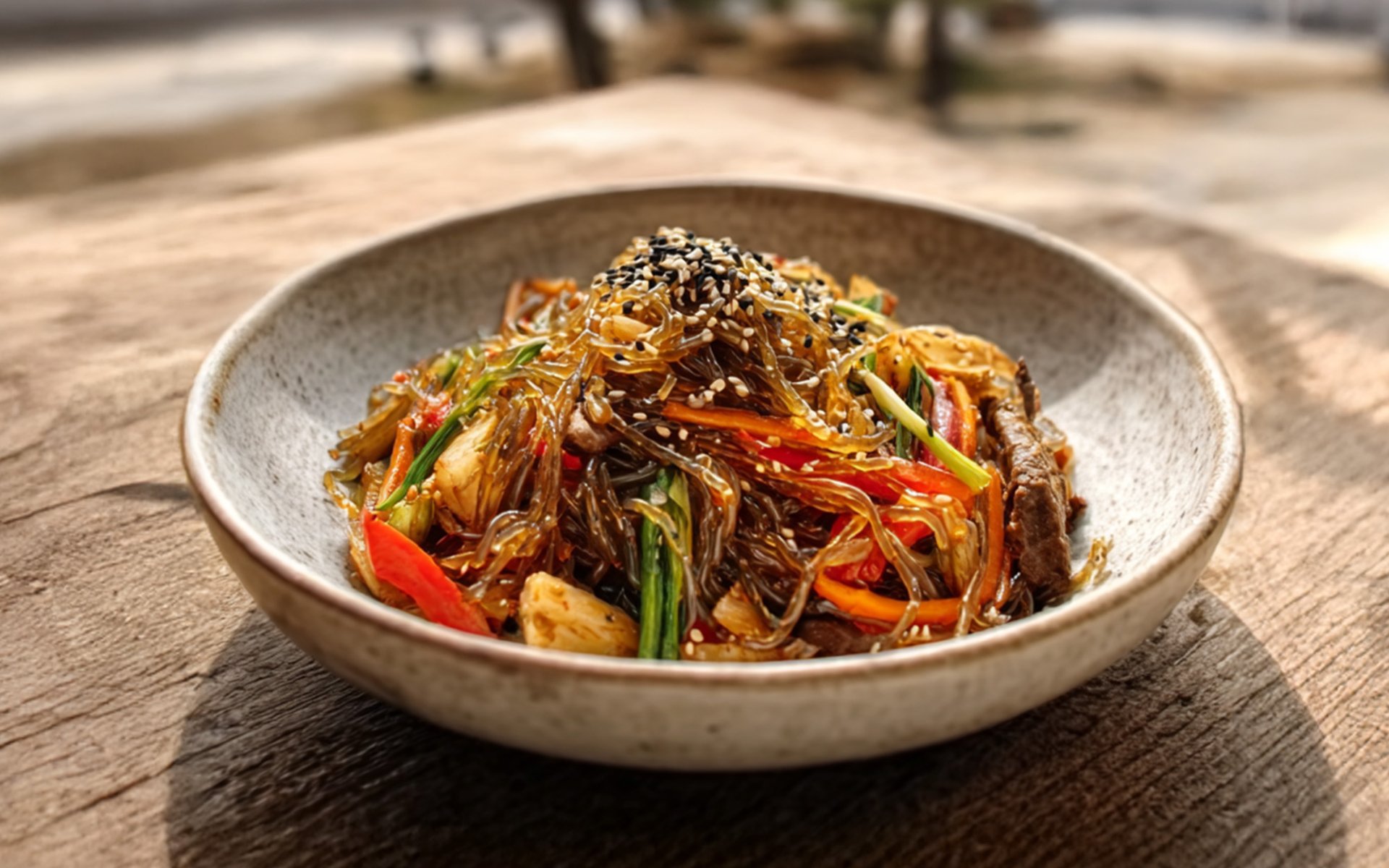Japchae (잡채)
Last updated: 2 Sept 2025

Japchae (잡채), often translated into English as Korean Glass Noodle Stir Fry, is a well-known Korean dish made from Dangmyeon (sweet potato glass noodles), stir-fried with a variety of vegetables such as carrots, onions, shiitake mushrooms, spinach, and bell peppers. It often includes meat, typically beef or pork, and is seasoned with soy sauce, sugar, and sesame oil.
The word Japchae literally means mixed vegetables in Korean, reflecting the dishs defining characteristican assortment of colorful vegetables cooked together.
At that time, Japchae did not include glass noodles or meat. Instead, it was made with stir-fried vegetables and mushrooms, seasoned with simple condiments. When King Gwanghaegun tasted the dish, he enjoyed it so much that he rewarded Yi Chung with a promotion to a high-ranking government position. This royal favor elevated Japchae to the status of an official dish in the royal court, where it quickly gained recognition.
When cooked, sweet potato noodles turn translucent like glass and have a pleasantly chewy, elastic texture. They absorb sauces and flavors exceptionally well, adding both depth of flavor and nutritional value to the dish. This change made Japchae more filling and accessible to the general public, spreading its popularity across Korea.
Koreans believe that the long, chewy noodles symbolize longevity and prosperity, while the colorful variety of vegetables represents happiness, abundance, and harmony in life. Serving Japchae at celebrations is seen as a way of wishing the honoree a long, prosperous, and joyful life.
Japchaes global appeal is further boosted by growing interest in healthy eating. Since the dish is vegetable-based, relatively low in fat, and easy to adapt into vegetarian or vegan versions, it appeals to health-conscious consumers worldwide.
The word Japchae literally means mixed vegetables in Korean, reflecting the dishs defining characteristican assortment of colorful vegetables cooked together.
Origins in the Joseon Dynasty
The origins of Japchae date back to the early 17th century during the Joseon Dynasty. According to the Veritable Records of the Joseon Dynasty, the dish was first created by a court official named Yi Chung, who prepared it for King Gwanghaegun, the 15th ruler of the dynasty.At that time, Japchae did not include glass noodles or meat. Instead, it was made with stir-fried vegetables and mushrooms, seasoned with simple condiments. When King Gwanghaegun tasted the dish, he enjoyed it so much that he rewarded Yi Chung with a promotion to a high-ranking government position. This royal favor elevated Japchae to the status of an official dish in the royal court, where it quickly gained recognition.
Transformation with Sweet Potato Noodles
In the 20th century, sweet potato glass noodles were introduced from China to Korea. These noodles soon became an essential part of Japchae, giving the dish its modern identity.When cooked, sweet potato noodles turn translucent like glass and have a pleasantly chewy, elastic texture. They absorb sauces and flavors exceptionally well, adding both depth of flavor and nutritional value to the dish. This change made Japchae more filling and accessible to the general public, spreading its popularity across Korea.
Evolution and Ingredients
During the 20th century, families began adapting Japchae by adding meatsuch as beef, pork, or chickenfor protein and flavor. Some also began using thinly sliced egg yolk strips as garnish, enhancing both the visual appeal and taste of the dish.The essential ingredients of Japchae today are
- Dangmyeon (Korean sweet potato noodles)
- Vegetables such as onions, carrots, shiitake mushrooms, and spinach
- Meat (commonly thinly sliced beef)
- Seasonings made from soy sauce, sugar, sesame oil, and other condiments
Japchae as a Symbol of Celebration
Japchae has long been considered an auspicious dish in Korea, often served at important celebrations such as Dol (a childs first birthday) and Hwangap (a 60th birthday celebration).Koreans believe that the long, chewy noodles symbolize longevity and prosperity, while the colorful variety of vegetables represents happiness, abundance, and harmony in life. Serving Japchae at celebrations is seen as a way of wishing the honoree a long, prosperous, and joyful life.
Japchae in the Modern Era
In the 21st century, Japchae has gained worldwide popularity through the global spread of Korean cultureparticularly K-pop and K-dramaswhich often feature the dish. Today, most Korean restaurants abroad include Japchae as a signature menu item, and it is well-loved by international diners.Japchaes global appeal is further boosted by growing interest in healthy eating. Since the dish is vegetable-based, relatively low in fat, and easy to adapt into vegetarian or vegan versions, it appeals to health-conscious consumers worldwide.
Festivals and Culinary Innovation
In South Korea, Japchae festivals and cooking competitions are held annually. These events not only preserve traditional methods but also encourage creativity and innovation, inspiring chefs to experiment with new variations while keeping the cultural essence alive.Related Content
Getting to Know Pigs in Blankets One of the Most Popular Christmas Dishes in the United Kingdom
Tracing the History of Cranberry Sauce A Dish of Great Significance for Thanksgiving


